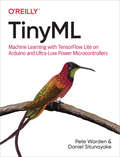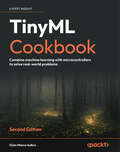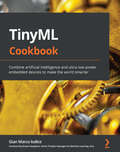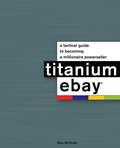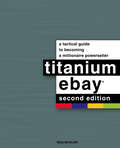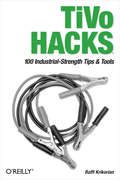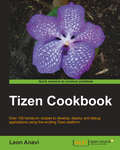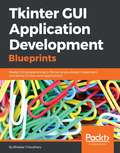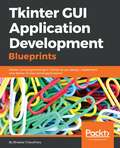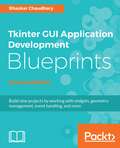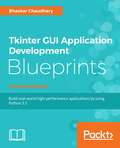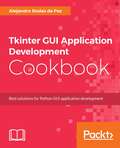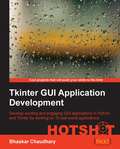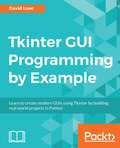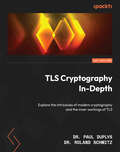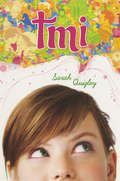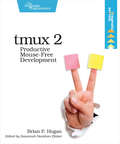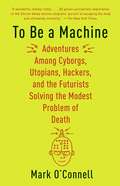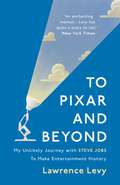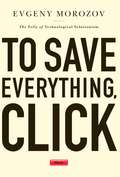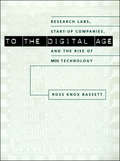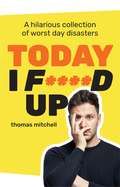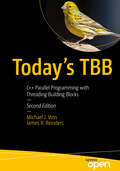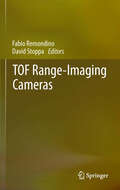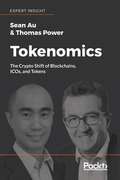- Table View
- List View
TinyML: Machine Learning with TensorFlow Lite on Arduino and Ultra-Low-Power Microcontrollers
by Pete Warden Daniel SitunayakeDeep learning networks are getting smaller. Much smaller. The Google Assistant team can detect words with a model just 14 kilobytes in size—small enough to run on a microcontroller. With this practical book you’ll enter the field of TinyML, where deep learning and embedded systems combine to make astounding things possible with tiny devices.Pete Warden and Daniel Situnayake explain how you can train models small enough to fit into any environment. Ideal for software and hardware developers who want to build embedded systems using machine learning, this guide walks you through creating a series of TinyML projects, step-by-step. No machine learning or microcontroller experience is necessary.Build a speech recognizer, a camera that detects people, and a magic wand that responds to gesturesWork with Arduino and ultra-low-power microcontrollersLearn the essentials of ML and how to train your own modelsTrain models to understand audio, image, and accelerometer dataExplore TensorFlow Lite for Microcontrollers, Google’s toolkit for TinyMLDebug applications and provide safeguards for privacy and securityOptimize latency, energy usage, and model and binary size
TinyML Cookbook: Combine machine learning with microcontrollers to solve real-world problems
by Gian Marco IodiceOver 70 recipes to help you develop smart applications on Arduino Nano 33 BLE Sense, Raspberry Pi Pico, and SparkFun RedBoard Artemis Nano using the power of machine learning Purchase of the print or Kindle book includes a free eBook in PDF format.Key FeaturesOver 20+ new recipes, including recognizing music genres and detecting objects in a sceneCreate practical examples using TensorFlow Lite for Microcontrollers, Edge Impulse, and moreExplore cutting-edge technologies, such as on-device training for updating models without data leaving the deviceBook DescriptionDiscover the incredible world of tiny Machine Learning (tinyML) and create smart projects using real-world data sensors with the Arduino Nano 33 BLE Sense, Raspberry Pi Pico, and SparkFun RedBoard Artemis Nano. TinyML Cookbook, Second Edition, will show you how to build unique end-to-end ML applications using temperature, humidity, vision, audio, and accelerometer sensors in different scenarios. These projects will equip you with the knowledge and skills to bring intelligence to microcontrollers. You'll train custom models from weather prediction to real-time speech recognition using TensorFlow and Edge Impulse.Expert tips will help you squeeze ML models into tight memory budgets and accelerate performance using CMSIS-DSP. This improved edition includes new recipes featuring an LSTM neural network to recognize music genres and the Faster-Objects-More-Objects (FOMO) algorithm for detecting objects in a scene. Furthermore, you’ll work on scikit-learn model deployment on microcontrollers, implement on-device training, and deploy a model using microTVM, including on a microNPU. This beginner-friendly and comprehensive book will help you stay up to date with the latest developments in the tinyML community and give you the knowledge to build unique projects with microcontrollers!What you will learnUnderstand the microcontroller programming fundamentalsWork with real-world sensors, such as the microphone, camera, and accelerometerImplement an app that responds to human voice or recognizes music genresLeverage transfer learning with FOMO and KerasLearn best practices on how to use the CMSIS-DSP libraryCreate a gesture-recognition app to build a remote controlDesign a CIFAR-10 model for memory-constrained microcontrollersTrain a neural network on microcontrollersWho this book is forThis book is ideal for machine learning engineers or data scientists looking to build embedded/edge ML applications and IoT developers who want to add machine learning capabilities to their devices. If you’re an engineer, student, or hobbyist interested in exploring tinyML, then this book is your perfect companion. Basic familiarity with C/C++ and Python programming is a prerequisite; however, no prior knowledge of microcontrollers is necessary to get started with this book.
TinyML Cookbook: Combine artificial intelligence and ultra-low-power embedded devices to make the world smarter
by Gian Marco Iodice Ronan NaughtonWork through over 50 recipes to develop smart applications on Arduino Nano 33 BLE Sense and Raspberry Pi Pico using the power of machine learningKey FeaturesTrain and deploy ML models on Arduino Nano 33 BLE Sense and Raspberry Pi PicoWork with different ML frameworks such as TensorFlow Lite for Microcontrollers and Edge ImpulseExplore cutting-edge technologies such as microTVM and Arm Ethos-U55 microNPUBook DescriptionThis book explores TinyML, a fast-growing field at the unique intersection of machine learning and embedded systems to make AI ubiquitous with extremely low-powered devices such as microcontrollers. The TinyML Cookbook starts with a practical introduction to this multidisciplinary field to get you up to speed with some of the fundamentals for deploying intelligent applications on Arduino Nano 33 BLE Sense and Raspberry Pi Pico. As you progress, you'll tackle various problems that you may encounter while prototyping microcontrollers, such as controlling the LED state with GPIO and a push-button, supplying power to microcontrollers with batteries, and more. Next, you'll cover recipes relating to temperature, humidity, and the three “V” sensors (Voice, Vision, and Vibration) to gain the necessary skills to implement end-to-end smart applications in different scenarios. Later, you'll learn best practices for building tiny models for memory-constrained microcontrollers. Finally, you'll explore two of the most recent technologies, microTVM and microNPU that will help you step up your TinyML game. By the end of this book, you'll be well-versed with best practices and machine learning frameworks to develop ML apps easily on microcontrollers and have a clear understanding of the key aspects to consider during the development phase.What you will learnUnderstand the relevant microcontroller programming fundamentalsWork with real-world sensors such as the microphone, camera, and accelerometerRun on-device machine learning with TensorFlow Lite for MicrocontrollersImplement an app that responds to human voice with Edge ImpulseLeverage transfer learning to classify indoor rooms with Arduino Nano 33 BLE SenseCreate a gesture-recognition app with Raspberry Pi PicoDesign a CIFAR-10 model for memory-constrained microcontrollersRun an image classifier on a virtual Arm Ethos-U55 microNPU with microTVMWho this book is forThis book is for machine learning developers/engineers interested in developing machine learning applications on microcontrollers through practical examples quickly. Basic familiarity with C/C++, the Python programming language, and the command-line interface (CLI) is required. However, no prior knowledge of microcontrollers is necessary.
Titanium eBay: A Tactical Guide to Becoming a Millionaire Powerseller
by Skip McgrathWhether you're an experienced PowerSeller looking to take your business to the highest level, or just starting out and wanting to avoid a novice's missteps and dead ends, Titanium eBay offers you a clear path to success.
Titanium Ebay, 2nd Edition: A Tactical Guide to Becoming a Millionaire Powerseller
by Skip McGrathHow to make it to the online big time! Titanium eBay® is for everyone who aspires to reach the highest level of success within eBay®, whether they've been selling for years or whether they're just starting out but have ambitious plans for their business. With 60 chapters that leave no stone unturned, this is truly the business bible for eBay® PowerSellers. • eBay® ended 2007 with over $8.7 billion in gross merchandise sales • There are 212 million global registered eBay® users operating across 23 international eBay® sites—twice as many as in 2004 • There are approximately 720,000 PowerSellers on eBay® who make a living selling merchandise through eBay®.
TiVo Hacks: 100 Industrial-Strength Tips & Tools
by Raffi KrikorianTiVo Hacks helps you get the most out of your TiVo personal video recorder. Armed with just a screwdriver and basic understanding of PC hardware (or willingness to learn), preeminent hackability awaits. This book includes hacks for changing the order of recorded programs, activating the 30-second skip to blaze through commercials, upgrading TiVo's hard drive for more hours of recording, use of TiVo's Home Media Option to remotely schedule a recording via the Web, log in to the serial port for command-line access to programming data, log files, closed-captioning data, display graphics on the TiVo screen, and even play MP3s.Readers who use advanced hacks to put TiVo on their home network via the serial port, Ethernet, USB, or wireless (with 802.11b WiFi) will watch a whole new world open up. By installing various open source software packages, you can use TiVo for mail, instant messaging, caller-ID, and more. It's also easy to run a web server on TiVo to schedule recordings, access lists of recorded shows, and even display them on a web site. While TiVo gives viewers personalized control of their TVs, TiVo Hacks gives users personalized control of TiVo.Note: Not all TiVos are the same. The original TiVo, the Series 1, is the most hackable TiVo out there; it's a box thrown together with commodity parts and the TiVo code is running on open hardware. The Series 2 TiVo, the most commonly sold TiVo today, is not open. You won't see hacks in this book that involve modifying Series 2 software.
Tizen Cookbook
by Leon AnaviIf you want to enter the fascinating world of Tizen and learn how to develop engaging and successful applications then this book is for you. It'll benefit novices and experienced application developers alike.
Tkinter GUI Application Development Blueprints
by Bhaskar ChaudharyMaster GUI programming in Tkinter as you design, implement, and deliver ten real-world applications from start to finish About This Book * Conceptualize and build state-of-art GUI applications with Tkinter * Tackle the complexity of just about any size GUI application with a structured and scalable approach * A project-based, practical guide to get hands-on into Tkinter GUI development Who This Book Is For Software developers, scientists, researchers, engineers, students, or programming hobbyists with basic familiarity in Python will find this book interesting and informative. People familiar with basic programming constructs in other programming language can also catch up with some brief reading on Python. No GUI programming experience is expected. What You Will Learn * Get to know the basic concepts of GUI programming, such as Tkinter top-level widgets, geometry management, event handling, using callbacks, custom styling, and dialogs * Create apps that can be scaled in size or complexity without breaking down the core * Write your own GUI framework for maximum code reuse * Build apps using both procedural and OOP styles, understanding the strengths and limitations of both styles * Learn to structure and build large GUI applications based on Model-View-Controller (MVC) architecture * Build multithreaded and database-driven apps * Create apps that leverage resources from the network * Learn basics of 2D and 3D animation in GUI applications * Develop apps that can persist application data with object serialization and tools such as configparser In Detail Tkinter is the built-in GUI package that comes with standard Python distributions. It is a cross-platform package, which means you build once and deploy everywhere. It is simple to use and intuitive in nature, making it suitable for programmers and non-programmers alike. This book will help you master the art of GUI programming. It delivers the bigger picture of GUI programming by building real-world, productive, and fun applications such as a text editor, drum machine, game of chess, media player, drawing application, chat application, screen saver, port scanner, and many more. In every project, you will build on the skills acquired in the previous project and gain more expertise. You will learn to write multithreaded programs, network programs, database driven programs and more. You will also get to know the modern best practices involved in writing GUI apps. With its rich source of sample code, you can build upon the knowledge gained with this book and use it in your own projects in the discipline of your choice. Style and approach An easy-to-follow guide, full of hands-on examples of real-world GUI programs. The first chapter is a must read as it explains most of the things you need to get started with writing GUI programs with Tkinter. Each subsequent chapter is a stand-alone project that discusses some aspects of GUI programming in detail. These chapters can be read sequentially or randomly depending upon the readers experience with Python.
Tkinter GUI Application Development Blueprints
by Bhaskar ChaudharyGeometry Management, Event Handling, and more Key Features A Practical, guide to learn the application of Python and GUI programming with tkinter Create multiple cross-platform real-world projects by integrating host of third party libraries and tools Learn to build beautiful and highly interactive user interfaces, targeting multiple devices. Book Description Tkinter is the built-in GUI package that comes with standard Python distributions. It is a cross-platform package, which means you build once and deploy everywhere. It is simple to use and intuitive in nature, making it suitable for programmers and non-programmers alike. This book will help you master the art of GUI programming. It delivers the bigger picture of GUI programming by building real-world, productive, and fun applications such as a text editor, drum machine, game of chess, audio player, drawing application, piano tutor, chat application, screen saver, port scanner, and much more. In every project, you will build on the skills acquired in the previous project and gain more expertise. You will learn to write multithreaded programs, network programs, database-driven programs, asyncio based programming and more. You will also get to know the modern best practices involved in writing GUI apps. With its rich source of sample code, you can build upon the knowledge gained with this book and use it in your own projects in the discipline of your choice. What you will learn -A Practical, guide to help you learn the application of Python and GUI programming with Tkinter - Create multiple, cross-platform, real-world projects by integrating a host of third-party libraries and tools - Learn to build beautiful and highly interactive user interfaces, targeting multiple devices. Who this book is for This book is for a beginner to intermediate-level Pythonists who want to build modern, cross-platform GUI applications with the amazingly powerful Tkinter. Prior knowledge of Tkinter is required.
Tkinter GUI Application Development Blueprints, Second Edition: Build Nine Projects By Working With Widgets, Geometry Management, Event Handling, And More, 2nd Edition
by Bhaskar ChaudharyTkinter is the built-in GUI package that comes with standard Python distributions. It is a cross-platform package, which means you build once and deploy everywhere. It is simple to use and intuitive in nature, making it suitable for learners. This book will enable you to use Tkinter effectively through working on nine versatile projects.
Tkinter GUI Application Development Blueprints, Second Edition: Build nine projects by working with widgets, geometry management, event handling, and more, 2nd Edition
by Bhaskar Chaudhary Erik S. RapertGeometry Management, Event Handling, and moreKey FeaturesA Practical, guide to learn the application of Python and GUI programming with tkinterCreate multiple cross-platform real-world projects by integrating host of third party libraries and toolsLearn to build beautiful and highly interactive user interfaces, targeting multiple devices.Book DescriptionTkinter is the built-in GUI package that comes with standard Python distributions. It is a cross-platform package, which means you build once and deploy everywhere. It is simple to use and intuitive in nature, making it suitable for programmers and non-programmers alike.This book will help you master the art of GUI programming. It delivers the bigger picture of GUI programming by building real-world, productive, and fun applications such as a text editor, drum machine, game of chess, audio player, drawing application, piano tutor, chat application, screen saver, port scanner, and much more. In every project, you will build on the skills acquired in the previous project and gain more expertise. You will learn to write multithreaded programs, network programs, database-driven programs, asyncio based programming and more. You will also get to know the modern best practices involved in writing GUI apps. With its rich source of sample code, you can build upon the knowledge gained with this book and use it in your own projects in the discipline of your choice.What you will learn-A Practical, guide to help you learn the application of Python and GUI programming with Tkinter- Create multiple, cross-platform, real-world projects by integrating a host of third-party libraries and tools- Learn to build beautiful and highly interactive user interfaces, targeting multiple devices.Who this book is forThis book is for a beginner to intermediate-level Pythonists who want to build modern, cross-platform GUI applications with the amazingly powerful Tkinter. Prior knowledge of Tkinter is required.
Tkinter GUI Application Development Cookbook: A practical solution to your GUI development problems with Python and Tkinter
by Alejandro Rodas de PazDiscover solutions to all your Tkinter and Python GUI development problemsKey Features Integrate efficient Python GUI programming techniques with Tkinter Efficiently implement advanced MVC architectures in your Python GUI apps Solve all your problems related to Tkinter and Python GUI developmentBook DescriptionAs one of the more versatile programming languages, Python is well-known for its batteries-included philosophy, which includes a rich set of modules in its standard library; Tkinter is the library included for building desktop applications. Due to this, Tkinter is a common choice for rapid GUI development, and more complex applications can benefit from the full capabilities of this library. This book covers all of your Tkinter and Python GUI development problems and solutions.Tkinter GUI Application Development Cookbook starts with an overview of Tkinter classes and at the same time provides recipes for basic topics, such as layout patterns and event handling. Next, we cover how to develop common GUI patterns, such as entering and saving data, navigating through menus and dialogs, and performing long-running actions in the background.You can then make your apps leverage network resources effectively and perform graphical operations on a canvas and related tasks such as detecting collisions between items. Finally, this book covers using themed widgets, an extension of Tk widgets that have a more native look and feel. Finally, this book covers using the canvas and themed widgets.By the end of the book, you will have an in-depth knowledge of Tkinter classes, and will know how to use them to build efficient and rich GUI applications.What you will learnAdd widgets and handle user eventsLay out widgets within windows using frames and the different geometry managersConfigure widgets so that they have a customized appearance and behaviorImprove the navigation of your apps with menus and dialogsApply object-oriented programming techniques in Tkinter applicationsUse threads to achieve responsiveness and update the GUI Explore the capabilities of the canvas widget and the types of items that can be added to itExtend Tkinter applications with the TTK (themed Tkinter) moduleWho this book is forThis book is for Python developers who are familiar with the basics of the language syntax, data structures, and OOP. You do not need previous experience with Tkinter or other GUI development libraries.
Tkinter GUI ApplicationDevelopment HOTSHOT
by Bhaskar ChaudharyPractical, real-world example projects. Start with the topics that grab your attention or work through each project in sequence.If you have just started with GUI programming, this book is ideal for you. This book is also great if you are an experienced software developer, scientist, researcher, engineer, student, or hobbyist.
Tkinter GUI Programming by Example: Learn to create modern GUIs using Tkinter by building real-world projects in Python
by David LoveLeverage the power of Python and its de facto GUI framework to build highly interactive interfacesKey Features The fundamentals of Python and GUI programming with Tkinter. Create multiple cross-platform projects by integrating a host of third-party libraries and tools. Build beautiful and highly-interactive user interfaces that target multiple devices.Book DescriptionTkinter is a modular, cross-platform application development toolkit for Python. When developing GUI-rich applications, the most important choices are which programming language(s) and which GUI framework to use. Python and Tkinter prove to be a great combination. This book will get you familiar with Tkinter by having you create fun and interactive projects. These projects have varying degrees of complexity. We'll start with a simple project, where you'll learn the fundamentals of GUI programming and the basics of working with a Tkinter application. After getting the basics right, we'll move on to creating a project of slightly increased complexity, such as a highly customizable Python editor. In the next project, we'll crank up the complexity level to create an instant messaging app. Toward the end, we'll discuss various ways of packaging our applications so that they can be shared and installed on other machines without the user having to learn how to install and run Python programs.What you will learn Create a scrollable frame via theCanvas widget Use the pack geometry manager andFrame widget to control layout Learn to choose a data structurefor a game Group Tkinter widgets, such asbuttons, canvases, and labels Create a highly customizablePython editor Design and lay out a chat windowWho this book is forThis book is for beginners to GUI programming who haven’t used Tkinter yet and are eager to start building great-looking and user-friendly GUIs. Prior knowledge of Python programming is expected.
TLS Cryptography In-Depth: Explore the intricacies of modern cryptography and the inner workings of TLS
by Dr. Paul Duplys Dr. Roland SchmitzA practical introduction to modern cryptography using the Transport Layer Security protocol as the primary referenceKey FeaturesLearn about real-world cryptographic pitfalls and how to avoid themUnderstand past attacks on TLS, how these attacks worked, and how they were fixedDiscover the inner workings of modern cryptography and its application within TLSPurchase of the print or Kindle book includes a free PDF eBookBook DescriptionTLS is the most widely used cryptographic protocol today, enabling e-commerce, online banking, and secure online communication. Written by Dr. Paul Duplys, Security, Privacy & Safety Research Lead at Bosch, and Dr. Roland Schmitz, Internet Security Professor at Stuttgart Media University, this book will help you gain a deep understanding of how and why TLS works, how past attacks on TLS were possible, and how vulnerabilities that enabled them were addressed in the latest TLS version 1.3. By exploring the inner workings of TLS, you’ll be able to configure it and use it more securely. Starting with the basic concepts, you’ll be led step by step through the world of modern cryptography, guided by the TLS protocol. As you advance, you’ll be learning about the necessary mathematical concepts from scratch. Topics such as public-key cryptography based on elliptic curves will be explained with a view on real-world applications in TLS. With easy-to-understand concepts, you’ll find out how secret keys are generated and exchanged in TLS, and how they are used to creating a secure channel between a client and a server. By the end of this book, you’ll have the knowledge to configure TLS servers securely. Moreover, you’ll have gained a deep knowledge of the cryptographic primitives that make up TLS.What you will learnUnderstand TLS principles and protocols for secure internet communicationFind out how cryptographic primitives are used within TLS V1.3Discover best practices for secure configuration and implementation of TLSEvaluate and select appropriate cipher suites for optimal securityGet an in-depth understanding of common cryptographic vulnerabilities and ways to mitigate themExplore forward secrecy and its importance in maintaining confidentialityUnderstand TLS extensions and their significance in enhancing TLS functionalityWho this book is forThis book is for IT professionals, cybersecurity professionals, security engineers, cryptographers, software developers, and administrators looking to gain a solid understanding of TLS specifics and their relationship with cryptography. This book can also be used by computer science and computer engineering students to learn about key cryptographic concepts in a clear, yet rigorous way with its applications in TLS. There are no specific prerequisites, but a basic familiarity with programming and mathematics will be helpful.
Tmi
by Sarah QuigleyFriends call Becca the Overshare Queen, but her tendency for TMI never seemed like a problem to her until she blabs about her sweet band-geek boyfriend's sloppy kisses-and gets dumped! Realizing it may be better to resist the temptation to overshare face-to-face, Becca decides to blog anonymously about everything instead. On her blog, Too Much Information, Becca unleashes her alter ego, Bella. Bella tells it like it is . . . though perhaps with a bit more drama. After all, no one's going to read it, right?
tmux 2: Productive Mouse-Free Development
by Brian P. HoganYour mouse is slowing you down. The time you spend context switching between your editor and your consoles eats away at your productivity. Take control of your environment with tmux, a terminal multiplexer that you can tailor to your workflow. With this updated second edition for tmux 2.3, you'll customize, script, and leverage tmux's unique abilities to craft a productive terminal environment that lets you keep your fingers on your keyboard's home row. You have a database console, web server, test runner, and text editor running at the same time, but switching between them and trying to find what you need takes up valuable time and breaks your concentration. By using tmux 2.3, you can improve your productivity and regain your focus. This book will show you how. This second edition includes many features requested by readers, including how to integrate plugins into your workflow, how to integrate tmux with Vim for seamless navigation - oh, and how to use tmux on Windows 10. Use tmux to manage multiple terminal sessions in a single window using only your keyboard. Manage and run programs side by side in panes, and create the perfect development environment with custom scripts so that when you're ready to work, your programs are waiting for you. Manipulate text with tmux's copy and paste buffers, so you can move text around freely between applications. Discover how easy it is to use tmux to collaborate remotely with others, and explore more advanced usage as you manage multiple tmux sessions, add custom scripts into the tmux status line, and integrate tmux with your system. Whether you're an application developer or a system administrator, you'll find many useful tricks and techniques to help you take control of your terminal.
To Be a Machine: Adventures Among Cyborgs, Utopians, Hackers, and the Futurists Solving the Modest Problem of Death
by Mark O'ConnellAn eye-opening journey into a world of visionaries, billionaires, and eccentrics harnessing technology for nothing less than the salvation of mankindTranshumanism is a movement pushing the limits of our bodies—our capabilities, intelligence, and lifespans—in the hopes that, through technology, we can become something better than ourselves. It has found support among Silicon Valley billionaires and some of the world’s biggest businesses. In To Be a Machine, journalist Mark O'Connell explores the staggering possibilities and moral quandaries that present themselves when you of think of your body as a device. He visits the world's foremost cryonics facility to witness how some have chosen to forestall death. He discovers an underground collective of biohackers, implanting electronics under their skin to enhance their senses. He meets a team of scientists urgently investigating how to protect mankind from artificial superintelligence.Where is our obsession with technology leading us? What does the rise of AI mean not just for our offices and homes, but for our humanity? Could the technologies we create to help us eventually bring us to harm? Addressing these questions, O'Connell presents a profound, provocative, often laugh-out-loud-funny look at an influential movement. In investigating what it means to be a machine, he offers a surprising meditation on what it means to be human.
To Pixar and Beyond: My Unlikely Journey with Steve Jobs to Make Entertainment History
by Lawrence LevyA Sunday Times Best Book of the Year 2017 One day in November 1994, Lawrence Levy received a phone call out of the blue from Steve Jobs, whom he&’d never met, offering him a job running Pixar, a little-known company that had already lost Jobs $50 million. With Pixar&’s prospects looking bleak, it was with some trepidation that Levy accepted the position. After a few weeks he discovered that the situation was even worse than he&’d imagined. Pixar&’s advertising division just about broke even, its graphics software had few customers, its short films didn&’t make any money and, on top of all that, Jobs was pushing to take the company public. Everything was riding on the studio&’s first feature film, codenamed Toy Story, and even then it would have to be one of the most successful animated features of all time… Full of wisdom on bringing business and creativity together, and recounting the touching story of Levy&’s enduring friendship with Jobs, To Pixar and Beyond is a fascinating insider&’s account of one of Hollywood&’s greatest success stories.
To Save Everything, Click Here: The Folly of Technological Solutionism
by Evgeny MorozovThe award-winning author of "The Net Delusion" shows how the radical transparency we've become accustomed to online may threaten the spirit of real-life democracy
To the Digital Age: Research Labs, Start-up Companies, and the Rise of MOS Technology (Johns Hopkins Studies in the History of Technology)
by Ross Knox BassettThe metal-oxide-semiconductor (MOS) transistor is the fundamental element of digital electronics. The tens of millions of transistors in a typical home—in personal computers, automobiles, appliances, and toys—are almost all derive from MOS transistors. To the Digital Age examines for the first time the history of this remarkable device, which overthrew the previously dominant bipolar transistor and made digital electronics ubiquitous. Combining technological with corporate history, To the Digital Age examines the breakthroughs of individual innovators as well as the research and development power (and problems) of large companies such as IBM, Intel, and Fairchild.Bassett discusses how the MOS transistor was invented but spurned at Bell Labs, and then how, in the early 1960s, spurred on by the possibilities of integrated circuits, RCA, Fairchild, and IBM all launched substantial MOS R & D programs. The development of the MOS transistor involved an industry-wide effort, and Bassett emphasizes how communication among researchers from different firms played a critical role in advancing the new technology. Bassett sheds substantial new light on the development of the integrated circuit, Moore's Law, the success of Silicon Valley start-ups as compared to vertically integrated East Coast firms, the development of the microprocessor, and IBM's multi-billion-dollar losses in the early 1990s. To the Digital Age offers a captivating account of the intricate R & D process behind a technological device that transformed modern society.
Today I F****d Up
by Thomas MitchellA toe curling, laugh out loud collection of worst day disasters. I&’d always rolled my eyes when people describe things as 'happening in slow motion'. Surely everything happens in regular time and it's only when you replay it in your head that it seems to slow down?But as the car lurched forward and I found myself sailing through the back of the garage, I finally understood what they meant. When a trip to meet his new girlfriend&’s grandparents ends in disaster (think a crashed ute, an angry wasp and a cranky farmer with a shotgun), Thomas Mitchell knows one thing for sure: bad days make for great stories. While we might not like to admit it, we can't help but find a sneaky pleasure in other people's misfortune. It's the reason fail compilations rack up millions of views on YouTube or television shows like Funniest Home Videos exist at all. Deep down we're addicted to the downfall of our fellow humans, and if there was ever a point in history when we needed a laugh, it's now. Today I F***D Up is a collection of tall tales but true that are equal parts hilarious and horrifying; a timely reminder that no matter how terrible things get, they could always be worse. So much worse.
Today's TBB: C++ Parallel Programming with Threading Building Blocks
by Michael J. Voss James R. ReindersThis open-access book serves as a comprehensive guide for C++ programmers looking to master Threading Building Blocks (TBB). Authored by two experts in TBB and parallel programming, the book distills decades of collective experience in developing and teaching parallel programming concepts, presenting insights in a clear and accessible manner. Today&’s TBB starts with foundational principles, explaining key concepts and terminology used in parallel programming. It then introduces the major components of TBB including parallel algorithms, flow graphs, and task groups that help you fully leverage the power of multicore systems. The book emphasizes TBB's higher-level parallelism capabilities, which facilitate the creation of portable, scalable applications for modern CPUs. Key topics, including memory management in parallel contexts and effective synchronization for data structures, are well explored, ensuring a comprehensive understanding of these critical concepts. Later chapters delve into advanced topics including cancellation, exception handling, composability, performance tuning, and transitioning legacy code from older versions of TBB to Today&’s TBB. For nearly two decades, TBB has been invaluable to programmers, and this book leverages the latest advancements in C++ alongside TBB to enhance your parallel programming capabilities. TBB excels in unlocking the performance of code that is not well-suited for accelerators, making it an essential tool in the realm of parallel computing. If you work with technologies like CUDA, SYCL, or OpenCL for accelerated computing, mastering TBB will also enable you to orchestrate parallelism effectively on the host CPU, optimizing performance in the face of Amdahl&’s Law. What You'll Learn Create Scalable Code: Use TBB for portable, simple, and efficient programming. Parallelization Strategies: Implement best practices for intensive tasks. High-Performance Applications: Develop scalable parallel programs. Modern C++ Compatibility: Apply TBB with C++17 and later. Code Migration: Update legacy TBB code to leverage C++17 and Today&’s TBB. Think Parallel: Orchestrate parallelism in the entire computer system to your advantage. Who This Book Is For C++ programmers eager to harness the power of parallelism on multicore systems. Today&’s TBB is accessible to those with limited experience, with C++ or parallelism, providing clear guidance on best practices and techniques. Experienced programmers will find valuable insights for refining their skills, addressing advanced topics such as cancellation, exception handling, composability, and performance tuning. No prior experience in parallel programming or multicore processors is necessary; however, those with some background will discover even more depth and value throughout the book.
TOF Range-Imaging Cameras
by David Stoppa Fabio RemondinoToday the cost of solid-state two-dimensional imagers has dramatically dropped, introducing low cost systems on the market suitable for a variety of applications, including both industrial and consumer products. However, these systems can capture only a two-dimensional projection (2D), or intensity map, of the scene under observation, losing a variable of paramount importance, i.e., the arrival time of the impinging photons. Time-Of-Flight (TOF) Range-Imaging (TOF) is an emerging sensor technology able to deliver, at the same time, depth and intensity maps of the scene under observation. Featuring different sensor resolutions, RIM cameras serve a wide community with a lot of applications like monitoring, architecture, life sciences, robotics, etc. This book will bring together experts from the sensor and metrology side in order to collect the state-of-art researchers in these fields working with RIM cameras. All the aspects in the acquisition and processing chain will be addressed, from recent updates concerning the photo-detectors, to the analysis of the calibration techniques, giving also a perspective onto new applications domains.
Tokenomics: The Crypto Shift of Blockchains, ICOs, and Tokens
by Sean Au Thomas Power<p>Tokenomics is the economy of this new world. This is a no-holds-barred, in-depth exploration of the way in which we can participate in the blockchain economy. The reader will learn the basics of bitcoin, blockchains, and tokenomics; what the very first ICO was; and how over a period of 5 years, various projects managed to raise the enormous sums of money they did. The book then provides insights from ICO experts and looks at what the future holds. By comparing the past, current, and future of this technology, the book will inform anyone, whatever motivates their interest. <p>The crypto shift of blockchains, ICOs, and tokens is much more than just buying bitcoins, creating tokens, or raising millions in a minute in an ICO. It is a new paradigm shift from centralized to decentralized, from closed to open, and from opaqueness to transparency. ICOs and the creation of tokens during the craze of 2017 needed a lot of preparation, an understanding of cryptocurrencies and of emerging legal frameworks, but this has spurred a new movement to tokenize the world. <p>The author gives an unbiased, authoritative picture of the current playing field, exploring the token opportunities and provides a unique insight into the developing world of this tokenized economy. This book will nourish hungry minds wanting to grow their knowledge in this fascinating area.</p>
